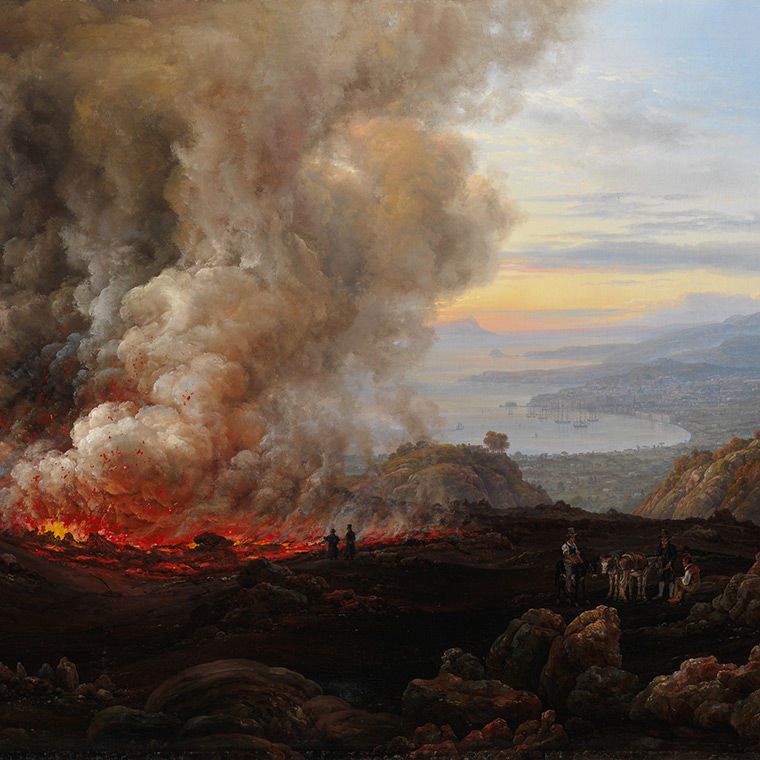This moonlit scene is a view of Nordkaap, or the North Cape, from the sea. That is how Balke saw it, only once, in 1832. In the nineteenth century, the North Cape was thought to be the northernmost point in Europe. No motif is more closely associated with Balke. It is a symbol of his self-identification as a Norwegian artist.
One point of departure for consideration of the painting is a daylight view,
The North Cape, dated 1845 (oil on canvas, 37 3/8 x 52 in., The Savings Bank Foundation DNB, Norway). It it is one of Balke’s largest easel paintings, and among the most accomplished and sophisticated works he made in the descriptive, naturalistic vein of his contemporaries Johan Christian Dahl and Thomas Fearnley. Three years later, in 1848, Balke executed essentially the same view on an even larger canvas, this time as a night scene, in
The North Cape in Moonlight (see fig. 1 above). It is possible, though by no means certain, that the latter painting served as a model for the present one. Both were undoubtedly painted in Dresden, where Balke had sought out Dahl, and where he spent the better part of 1848.[1] All the major elements of the composition are the same in both paintings, with variations in some details, such as the reduced number of figures in the rowboat in The Met's picture.
One significant difference between the two is that in the smaller version the artist is less bound to the emphatic choreography of the clouds ringing the moon. The brushwork is more open overall, not only in the sky but in the reflections on the rippled surface of the water. Balke’s paintings were rooted in personal experience, and this one exemplifies the union of naturalism based on observation with a range of concentrated, painterly effects that would come to play an increasingly expressive, even assertive, role in his work. In this respect, Balke was something of a maverick artist, and a controversial one: in the turbulent year 1848, the date of this painting, Dahl wrote disapprovingly of Balke’s warm, yellow-brown tones, noting that the younger painter was "now a Communist, and has here and especially in Paris concerned himself more with politics than with studying the art of painting."[2]
The following description was included in an anonymous review of an exhibition held at the Christiania Art Society in the periodical
Morgenbladet on November 28, 1848:
"Balke’s
North Cape in Moonlight [Nordkap ved Maaneskin] is deserving of interest on account of the nature of the subject, but also because of the particularity of the perception of the chosen moment. The dark precipice, protruding into the bright light of the rising moon, with its steep drop and the horizontal outline of its plateau at the foot of which the polar sea is quietly rocking, does not fail to affect the imagination of the spectator, which has already been moved by the very title of the work. It would have been highly advantageous for the whole if the air had been treated as well as the water. Nor is the whitish tone of the moonshine spread across the surface of the sea entirely satisfactory. In any case, this painting must be regarded one of the most successful we have seen by this artist, its lack of detail well suited to recreate a memory of this kind."[3]
It is not clear from the review which version of the painting is discussed, though it stands to reason that the artist sent the larger one to the exhibition.
There are innumerable later treatments of the subject on the same scale as The Met picture or smaller, which demonstrate the range of Balke’s painting techniques in the years that followed. These include an 1853 version of
The North Cape in Moonlight and another,
undated version, which is no larger than a postcard. Much about Balke’s life and career remains unknown. Balke often left his paintings undated, and their ownership and early exhibition histories are often poorly documented. These factors, and the obscurity into which the artist fell from the 1860s onward—he was utterly forgotten as a painter by the time of his death in 1887—have limited the ability of scholars to contextualize his work.
Asher Miller 2019
[1] The present canvas is mounted on a Dresden-type stretcher (Marit Ingeborg Lange, email, February 14, 2017, European Paintings files).
[2] Excerpt quoted in translation by Marit Ingeborg Lange in
Paintings by Peder Balke, exh. cat., National Gallery, London, 2015, p. 35.
[3] The original text may be found online: http://www.nb.no/nbsok/nb/755e0037088f7d07db4939121d58893a?index=1. Translated from the Norwegian by Niels Henriksen and Marit Ingeborg Lange.




